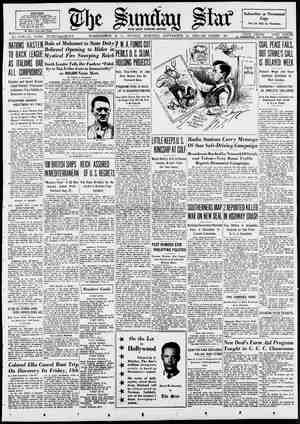Evening Star Newspaper, September 15, 1935, Page 99
You have reached the hourly page view limit. Unlock higher limit to our entire archive!
Subscribers enjoy higher page view limit, downloads, and exclusive features.
| -1 Magazine Section HE ruins of the ancient Assyrian metropolis Nineveh lie on the cast bank of the Tigris River in northern Mesopotamia the kingdom of Iraq, as it is now called. On a clear day one may look north from these ruins and see, fourteen miles away on the same side of the muddy Tigris, an immense mound. The mound is not so immense today as it was eight years ago, for in the interim its top has been sliced otf and a segment on one side has been notched down almost to the base level — the results of archeological excavation of the site. These efforts have been richly repaid by the discovery of some of the most antique finds of modern times, including buried temples, tombs, dwellings and other human remains so old that they carry our knowledge of civilization back hundreds of additional years, bevond the earliest settle- ments heretofore known, perhaps to the very beginnings ol life in organized civic com- munities. Indeed, we may say with con- siderable contidence that here in Tepe Gawra a Kurdish name meaning ‘‘great mound'’ liave been uncovered the oldest known cities of this planet. For centuries Tepe Gawra has stood there, rising abruptly out of the level plain, clearly not a natural formation - a curious challenge to the passing traveler, an obvious bump on the landscape. To the north are the Kurdish mountains, but southward stretches the level plain of the river valleys. When archeologists hegan to come into the country in the Nine- teenth Century, their first interest was the famous capitals -~ Babylon, Nippur, Assur, " Nineveh, Khorsabad, Ur of the Chaldees and others. Magnificent palaces and temples were unearthed, huge pieces of sculpture, monu- ments and tablets inscribed in cuneiform writing, and stores of tools, ornaments, house- hold implements, pottery and other relics of human habitation. Among the pottery remains were a few scattered specimens of earthenware marked by striking geometric designs painted in reddish colors, ranging from dark brown to light pink. This pottery is so distinctive, its antiquity so great, and its art so individual that it became recognized as the significant symbol of its makers, whom we know only as “the painted pottery peoples.” We do not know whence they came. Traces of them have been found over a wide area, and it appears that about 6000 years before Chris* ‘‘the painted pottery peoples’’ overran a large part of India, Persia and Mesopotamia. Evidently they were a superior race, dominating the prehistory of this birthplace of civilization — and the interest of archeologists in them has rapidly accelerated in recent years, During 1927 the American orientalist, Dr. E. A. Speiser, was pursuing this fascinating trail in the Tigris-Euphrates valley, and it occurred to him to prospect Tepe Gawra for the painted pottery. No archeologist had struck a spade into the mound up to that time, so far as we know. Dr. Speiser's explo- ratory trench had advanced only a few feet hefore he encountered the foundation of a wall. He ran a shallow excavation up the slope of the mound, and found layer after layer of structures, indicating that the site had been occupied over a long period. The succession The “Great Mound” as it appeared last March. Central chamber of a temple found on the eleventh level Below — A typical THIS WEEK Oldest City 0,000 years ago a Stone ~Age family left their dinner, and fled. Science has traced their story in the rutns of the oldest city yet found. Older cities, buried deeper, soon will be uncovered by CHARLES BACHE Field Director, Joint Assyrian Expedition of the Unizersity of Pennsvivania Museum and the American Schools of Oriental Research .\lesopotamian At sides: Solid gold rosettes found there The World’s A building of Stratum XII. Here the White Room was found ~3 of settlements suggested that here was a promising center for a systematic study of “the painted pottery peoples.” An arrange- ment was made with the kingdom of Iraq by which the University of Pennsylvania Mu- seum and the American Schools of Oriental Research were jointly granted the right to excavate Tepe Gawra, and since 1930 the work has been pressed steadily. From 1927 until the Spring of 1932 the excavations were carried en under Professor Speiser, of the University of Pennsylvania. Since that time the writer has been in charge of the work. We began at the top and worked down- ward. The topmost ruin, which was hidden under a thin layer of soil deposited by cen- turies of wind storms, was a single structure, seemingly a watch tower. But a few feet underneath it we came upon four small build- ings arranged around a court. The construc- tion was of mud brick —and this, I may explain, is the building material used through- out the various layers. There was no stone construction except in the sixth level and later, where stone was used in foundations; and of course any wooden construction perished long ago. Each level. as it was excavated, was care- fully studieda as to architectural detail. All its features were photographed inside and out, and the pottery. ornaments, tools and other relics were carefully removed and preserved. Then the walls were demolished — the heavy rains would eventually destroy the soft brick anyhow — and the ground cleared for the unearthing of the next layer. In this way we have progressed through twelve layers — twelve successive cities — (Continuea on page 10)
